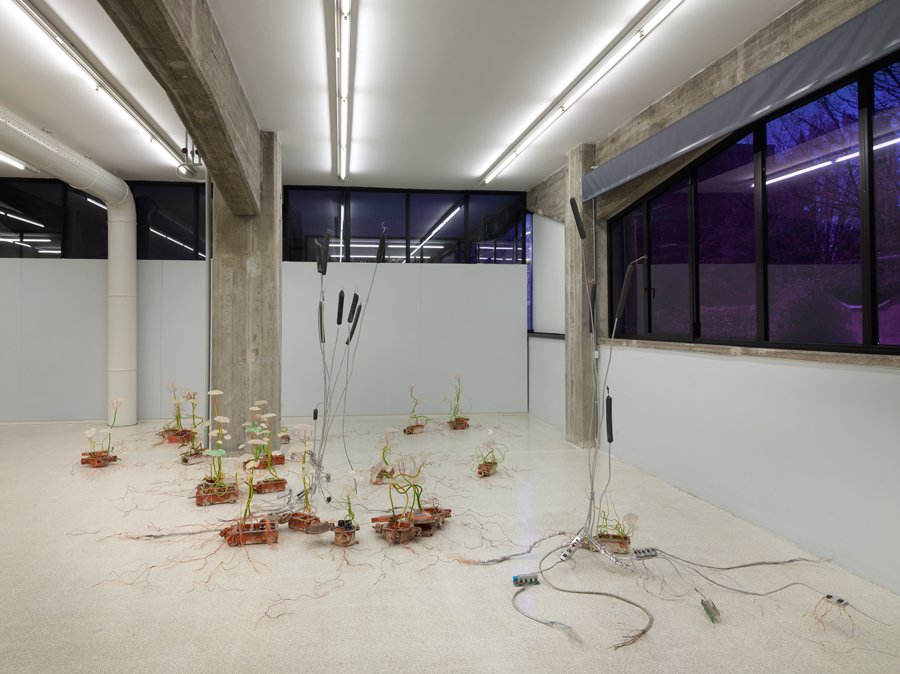Krištof Kintera
Collezione Maramotti, Reggio Emilia, Italy
Collezione Maramotti, Reggio Emilia, Italy

What can we learn from fungi? Mycelium, the spongy tissue that distributes nutrients to the caps and stems of humble mushrooms, resembles both the neural synapses of animal brains and the complex wiring of computers. It also links the anatomy of one discrete fungus to another, conjoining them like human twins with a shared nervous system – a kind of network collectivity, courtesy of evolutionary biology.
For the past year, mycelium has been on Krištof Kintera’s mind. I know this because I saw diagrams of the stuff taped to the walls of the Czech artist’s makeshift studio at the Collezione Maramotti, the site of ‘Postnaturalia’, his latest exhibition. These drawings – torn or scanned from botanical field books – appear beside grainy, photocopied aerial photographs of cityscapes, as though London might be an ancient moss, its blocks and buildings like spores bearing chaotic yet complex spatial logic. These studio materials were inspiration for Systemus Postnaturalis (all works 2016–17), the sprawling installation that occupies a wide concrete gallery in Maramotti’s adjacent exhibition space. Mounds of amassed electronic waste weave across the polished whitewashed floor, linked by salvaged cables, the bright colours of their rubber tubing dulled by streaks of oil and glue. Hundreds of tiny box-shaped transistors dot dozens of dismantled circuit boards, jutting up like Lilliputian houses from hillocks of melted fibreglass, epoxy and metallic foil. The most beautiful of Kintera’s forms are shorn copper wires, their ends dipped in semi-translucent green and yellow resin, sprouting from the gallery’s corners like stalks of wild cauliflower. Above all this, the gallery lights slowly pulse, casting the artist’s unnatural growths in a faintly radioactive pall.

Kintera began the project after a visit to the Musei Civici, a fascinating and creepy 19th-century anthropology museum in the historic centre of Reggio Emilia. The museum’s dimly lit, labyrinthine Wunderkammer displays are packed with everything from ancient fossils to human genitalia pickled in formaldehyde; the spoils of safari are mounted in a grand entry hall. Inspired by a room of rare, colourfully preserved fungi, Kintera produced his own specimens using materials fished from a local electronic rubbish dump. Some of these are temporarily on display in the museum’s locked cabinets, with names like Gratia Informatica or Radaria Pulsa that ape Linnaean classification.
Mounted in vitrines or on wooden boards, like flowers pressed in a book, the sculptures’ direct resemblance to familiar plants feels obvious and heavy-handed. The exhibition’s main installation, though, is a stunning work of craftsmanship; placed in a larger ecosystem, Kintera’s flora reflect macroscopic issues. The most intelligent human technologies exhibit a certain organic order for which fungi are an apt analogy. Our cities are sublime engines of chance, greater than any supercomputer: they transmit information and facilitate movement at a scale and complexity comparable only, perhaps, to the mycelium that links together the kingdom Fungi.

Kintera insists that we live in a Copper Age. The term echoes early human history – Iron and Bronze – but, in fact, refers to the indispensable conductor of currents in our electronic devices. Without copper, his reasoning goes, we might slide into a literal dark age. While not entirely accurate – silicone’s ability to conduct electricity is already enabling advances in bionic implants – the notion aptly reflects this exhibition’s greatest success. None of Kintera’s materials will ever decompose: like all ‘e-waste’, they sat leaching toxic petrochemicals into dumpsite soil before he found them. By repurposing this junk and returning it implausibly to nature, Kintera reminds us that it all once came from the earth. The internet – the manmade mycelium that powers modern life – relies on an infrastructure built of minerals mined from conflict zones: tungsten from Rwanda, coltan from the Congo. Human labour extracts these materials and transforms them so they may never be the same again.
Main image: Krištof Kintera, ‘Postnaturalia’ (detail), 2017, installation view, Collezione Maramotti, Reggio Emilia. Photograph: Sofia Picariello























